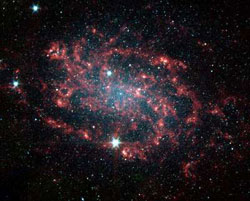The universe has many planets like Earth
A recent study by American astronomers demonstrated that Earth-like planets - meaning not too hot and too cold for life to develop - are quite common in the universe.
Experts at Northwestern University, Illinois, USA use the latest data on 300 planets orbiting stars to build models of planetary formation, including the solar system. our.
 The large-scale models of the team have for the first time reconstructed the process of forming planets around a star. They are made up of disks of gas and dust left behind by the formation of the central star. From those physical disks, a full planetary system was born. Previous models provided only basic information about the causes of planet formation.
The large-scale models of the team have for the first time reconstructed the process of forming planets around a star. They are made up of disks of gas and dust left behind by the formation of the central star. From those physical disks, a full planetary system was born. Previous models provided only basic information about the causes of planet formation.
The first stage in the formation of planetary systems takes place in chaos and violence. The giant gas disk forms planets, but then pushes them toward the central star, where they cluster into groups. A fierce competition among the growing planets takes place. They race to "swallow" gas and dust to bulge. This process creates a variety of sizes of planets.
As planets approach each other, gravity forces them to "lock" in elliptical orbits. The perimeter of the giant ellipses increases with time, until they are able to "throw" the planets to many places in the universe. It is very likely that the Earth has experienced the same situation.
Professor Edward Thommes, a member of the research team, asserts that the planets in which the rock occupies most of the surface like the Earth have many favorable conditions to survive. He thinks they appear everywhere in the universe.
- Image of Earth seen from other planets in the universe
- The Milky Way has billions of planets close to Earth
- Discover 140 earth-like planets
- Discover more than 700 planets outside the solar system
- Discovered two planets that closely resemble the earth
- The 'orphaned' planets in the universe
- Water turns out to be full of our galaxy, and so is life
- Discovered 'Earth materials' in 18 other planetary systems
- Earth map and planets
- Discovering 'Earth Stone' has 3 suns at the same time
- Dozens of planets have life like Earth
- Why can't we 'encounter' aliens?
 Van Allen's belt and evidence that the Apollo 11 mission to the Moon was myth
Van Allen's belt and evidence that the Apollo 11 mission to the Moon was myth The levels of civilization in the universe (Kardashev scale)
The levels of civilization in the universe (Kardashev scale) Today Mars, the sun and the Earth are aligned
Today Mars, the sun and the Earth are aligned The Amazon owner announced a secret plan to build a space base for thousands of people
The Amazon owner announced a secret plan to build a space base for thousands of people Chilling discovery of cosmic object that almost brought the Earth to 'apocalypse'
Chilling discovery of cosmic object that almost brought the Earth to 'apocalypse'  Admire 7 planets in the Solar System appearing at the same time in the night sky
Admire 7 planets in the Solar System appearing at the same time in the night sky  Does the Solar System have 5 more planets similar to Earth?
Does the Solar System have 5 more planets similar to Earth?  New discovery: 7 Earth-like planets that could be habitable
New discovery: 7 Earth-like planets that could be habitable  6 habitable planets discovered at the same time
6 habitable planets discovered at the same time  Strange Phenomenon: Why Are Planets 'Running Away' From the Sun Despite Their Extremely Strong Gravitational Force?
Strange Phenomenon: Why Are Planets 'Running Away' From the Sun Despite Their Extremely Strong Gravitational Force? 